MIAMI — There are no walls between the seven classrooms on the third floor of the Medical Academy for Science and Technology, a former hospital that houses a magnet high school for would-be doctors, nurses, physical therapists and pharmacists.
On a recent morning, the students in Isha Brown’s literature class were huddled in groups, analyzing the symbolism in “A Streetcar Named Desire.” At the other end of the basketball-court-size room, far enough to be out of earshot, students from another class took turns reciting speeches. A boy stood in front of a whiteboard in a corner, rehearsing his presentation on family planning. And on leather couches in the middle of the room, a cluster of students in scrubs chatted quietly, their IDs dangling from lanyards.
The space, upgraded in the 2015-2016 school year, is continuously changing. The seats in eye-catching blue, purple or orange might be lined up in neat rows, or rearranged in a circle for face-to-face discussion. All the furniture is fitted with wheels.
“The mobility helps in my debate class where I have about 37 students,” Brown said. “We can get three debates on three different topics going at the same time by just rearranging the tables. I can weave in and out, listening in, and then the kids rotate. More kids can participate. That couldn’t happen in a traditional classroom.”
The academy, known as MAST, is just one example of how schools are experimenting with classroom designs more conducive to the different ways students learn and, increasingly, the different ways teachers want to teach.
The idea isn’t new — there was a movement in the late 1960s to build “open classrooms” — but it’s made a comeback recently out of a desire to create a collaboration-minded workforce that will thrive in the open office spaces being built by companies such as Google and Facebook.
[…]
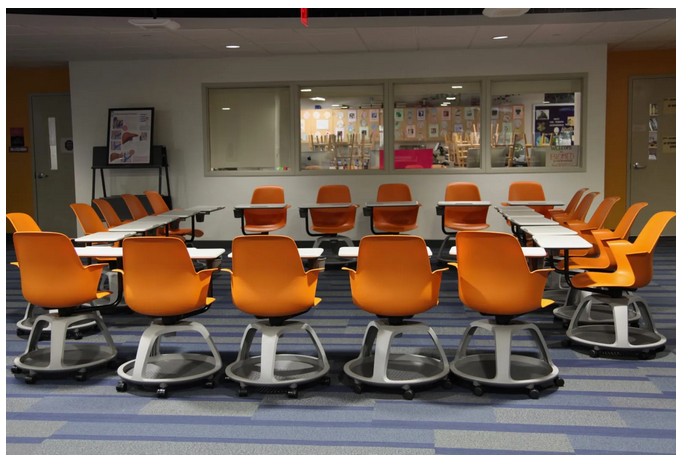
In other places, in the absence of schoolwide funding or administrative interest, the movement is grassroots as teachers revamp their classrooms themselves, spending their own money or even making their own furniture.
The idea of a classroom that can be rearranged to fit the activity — individual work, class discussion, group projects — has faced some pushback. Critics of the so-called open classroom argued in the 1970s that schools had attempted an overnight transformation without training teachers on how to adjust to the new space. Educators today have issued similar warnings.
Peter Barrett, the lead researcher for a 2015 study on classroom design in the United Kingdom and emeritus professor at the University of Salford, warns against “silver bullet” thinking. “I strongly believe teachers should be explicitly trained to see the physical classroom as a holistic element to be actively thought about and used to optimize children’s learning,” he said.
Building on brain science
For educators, this redesign movement isn’t about creating an Instagram-ready classroom filled with trendy standing tables and funky seating. It’s based on brain research that is still in the early stages but has shown that, when it comes to learning, space matters. A space that allows for movement can reduce student fatigue, improve performance and promote student collaboration.
Barrett’s study of 153 U.K. classrooms in 27 schools found that adjusting particular classroom characteristics — light and temperature, the amount of flexibility and student choice — boosted academic performance in reading, writing and math by 16 percent over the course of a year. A quarter of that improvement was attributed to letting students decide when to get up and where to sit. In 2016, a study using brain imaging to examine the effects of standing desks on high school students revealed improvements in working memory as well as in students’ ability to plan, organize and finish tasks.
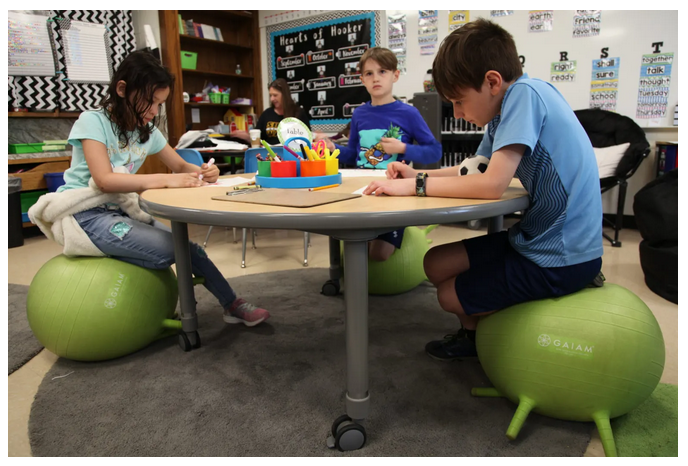
“Brain research tells us that movement in a classroom matters, choice matters,” said Robert Dillon, director of innovation for the University City school district in St. Louis, Missouri. His work consulting with districts and schools across the country on how to make the most of classroom redesigns has tripled in the past two years. “If kids don’t have these things, they will make these things happen,” he said. “They will be disruptive. They’ll get sent to the office. They’ll ask to go to the bathroom, just so they can have some space and the chance to move.”
Tuyler Sanford, 17, a student in Isha Brown’s literature class, said the classroom’s flexible setup “allows you to work at your own pace.” When students work in groups, he’s able to walk around and ask his fellow students for help. “It’s really communal,” he said. “The freedom is amazing.”
Keeping an eye on students working across such a large space may sound exhausting, but Brown said the effect on students, who are energized by the arrangement, is worth the effort. “Kids love the idea of constantly moving around and doing different projects, because they get tired if they’re expected to just sit in a room. I would get tired, too, so it really works out.”
[…]
“What we’re seeing is a shift from seat time to engagement,” said Jose Murguido, a partner at Zyscovich Architects who has designed several schools for Miami-Dade, including MAST. “You really have to understand how people learn, so that the time in the classroom is productive as opposed to just doing the time. If the learning environment is static, it will result in disengagement in young people.”
‘Fewer breaks in learning’
Brooke Markle, a seventh grade language arts teacher in Mechanicsburg, Pennsylvania, noticed several years ago that her students preferred doing their work anywhere but at their desks — on countertops, on the floor, under a desk, sitting on top of it. “I had 30 students, so the desks took up the entire room,” she said. “I decided they had to go.”
Two summers ago, she replaced the desks with vinyl, runnerless rockers and Adirondack chairs, adding spray-painted donated recycled tires and gallon-size plastic buckets with homemade cushions on top. She had no idea the results would be so dramatic.
“Kids stopped raising their hands to ask for bathroom breaks,” Markle said. “There were fewer breaks in learning. That was a pleasant surprise.”
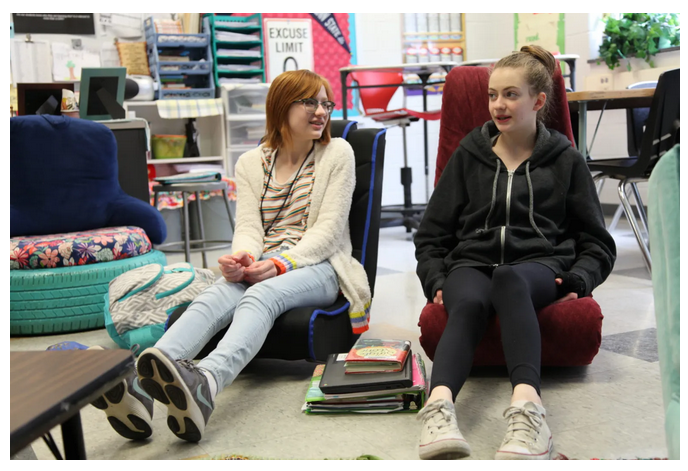
Last year, the Mechanicsburg Area School District began replacing desks with whatever type of furniture teachers thought would work best. “We are thinking more strategically in the district as a whole about how to change the learning environment to help our students gain the skills they’ll need after they graduate,” Markle said. “Students will need to innovate and collaborate. We see these changes as helping them to achieve that goal.”
At Thomas Hooker Elementary School in Meriden, Connecticut, two second grade teachers ditched the desks in their classrooms two years ago. On a recent morning in one of those revamped rooms, Melissa Sciarretto worked with a few students on their reading at a table, while the rest of the class sat on beanbag chairs and floor cushions, clicking through a game-based math program on their laptops.
Eight-year-olds Kamilla Armstrong and Juliette Ortiz sat on wobble stools next to a round table as they tackled math problems on their laptops. Kamilla pushed off on the table to set her chair spinning, fast. “This helps me think when my brain is full and I need a break,” she said.
“Actually, I think it distracts you,” Juliette said.
“Oh, really?” Kamilla responded. Juliette rolled her eyes and smiled before getting back to work.
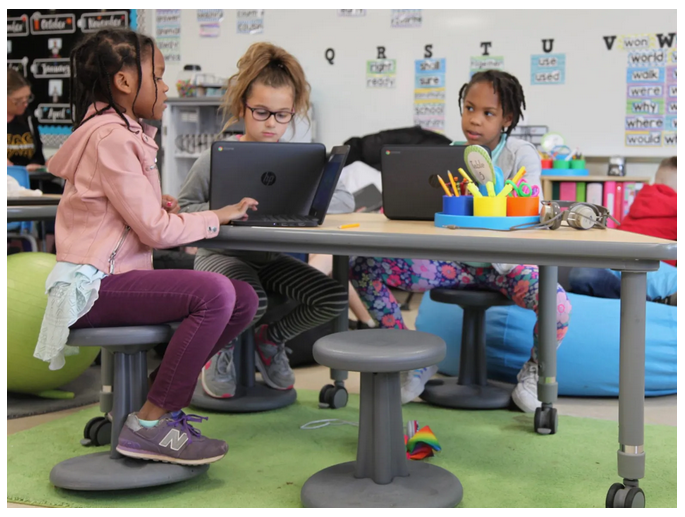
Sciarretto acquired the furniture using $4,000 in GoFundMe donations, combined with more than $6,000 from the school budget. “The seating is more collaboration-friendly,” she said. “When they look up, they see another kid, and so I think they naturally started going to each other for help from there.”
There are rules. Katie Somerset, 8, kneeled on a stability ball, balancing herself precariously as she worked. Sciarretto told Katie to sit correctly a few times, before sending her to a cushion on the floor. “I know I’m not supposed to kneel,” Katie said, “because it’s hard to control the ball. I could fall over.”
Small steps for success
It’s those types of distractions that drive some teachers crazy. Shaina Ramos, a second grade bilingual special education teacher at P.S. 257 in Brooklyn, knows the feeling well. Two years ago, she applied for grants through DonorsChoose to buy new furniture in her classroom: stability balls, floor rockers, wobble chairs, standing desks and tall stools.
The transition didn’t go smoothly at first. “I’d see a student moving out of the corner of my eye, and I would have to say ‘It’s OK; it’s OK’ to calm myself.”
But she stuck it out and the investment started paying off. Students with attention deficit disorder who were allowed to rock or wobble in their seats could concentrate for longer on tasks they usually dreaded, she said. They were writing complete paragraphs. They would get up, go to a dictionary, look up a word, walk over to a classmate and talk about the assignment.
“They weren’t just confined to their desks, forced to sit still and stare at a blank page,” Ramos said. “Eventually, I just told them, ‘As long as I see you’re working, go for it — rock, bounce, stand or move around.’”
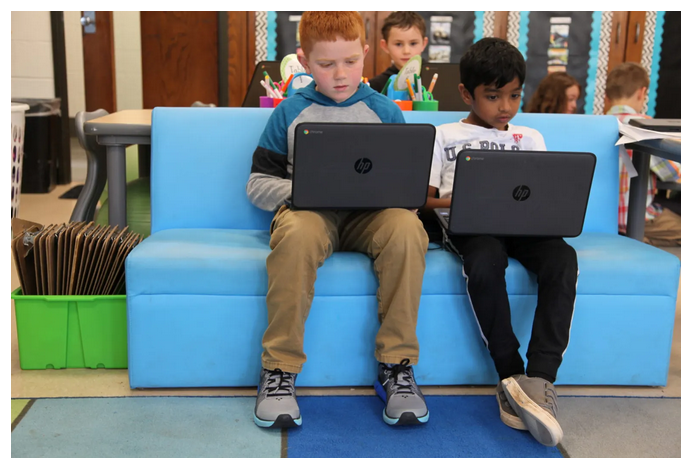
Last year, Ramos’ school tried flexible seating in all special education classrooms. But it didn’t work out — the teachers were frustrated by how much the students were moving during class, Ramos said. Some teachers added all-new furniture and then had to remove it entirely.
“Failure happens because people try to go from zero to 60, as opposed to saying ‘I am going to try this one little thing,’” Dillon said. He suggests teachers start by allowing kids to go to the back of the room and stand if they need to. Then, keep their attention and encourage collaboration by letting them use whiteboards. “The idea of ripping out all of your desks?” he said. “Setting yourself up for failure.”
But Murguido, who has designed more than 400 schools over the course of his 30-year career in Miami, across the country and as far afield as Germany, said classrooms need major changes to provide the right setting to help students succeed.
“Whatever the economy of the future, kids will need to learn to collaborate,” Murguido said. “The challenges that lie ahead are greater than any particular person can tackle individually.”
Iasevoli, Brenda. “Schools Are Rethinking Classroom Design to Encourage Collaboration, Creativity.” The Hechinger Report, The Hechinger Report, 30 Mar. 2020, https://hechingerreport.org/schools-are-rethinking-classroom-design-to-encourage-collaboration-creativity/.
This article gives several examples of successful flexible seating classrooms, as well as citing academic studies that support the benefit of these classroom designs. Given the strength of flexible seating in promoting collaboration, better quality learning, student-led education, and a variety of learning styles, it seems to be a good fit for the requirements of the DPP space. The photos in this article are quite inspiring for furniture types and layouts to consider.




